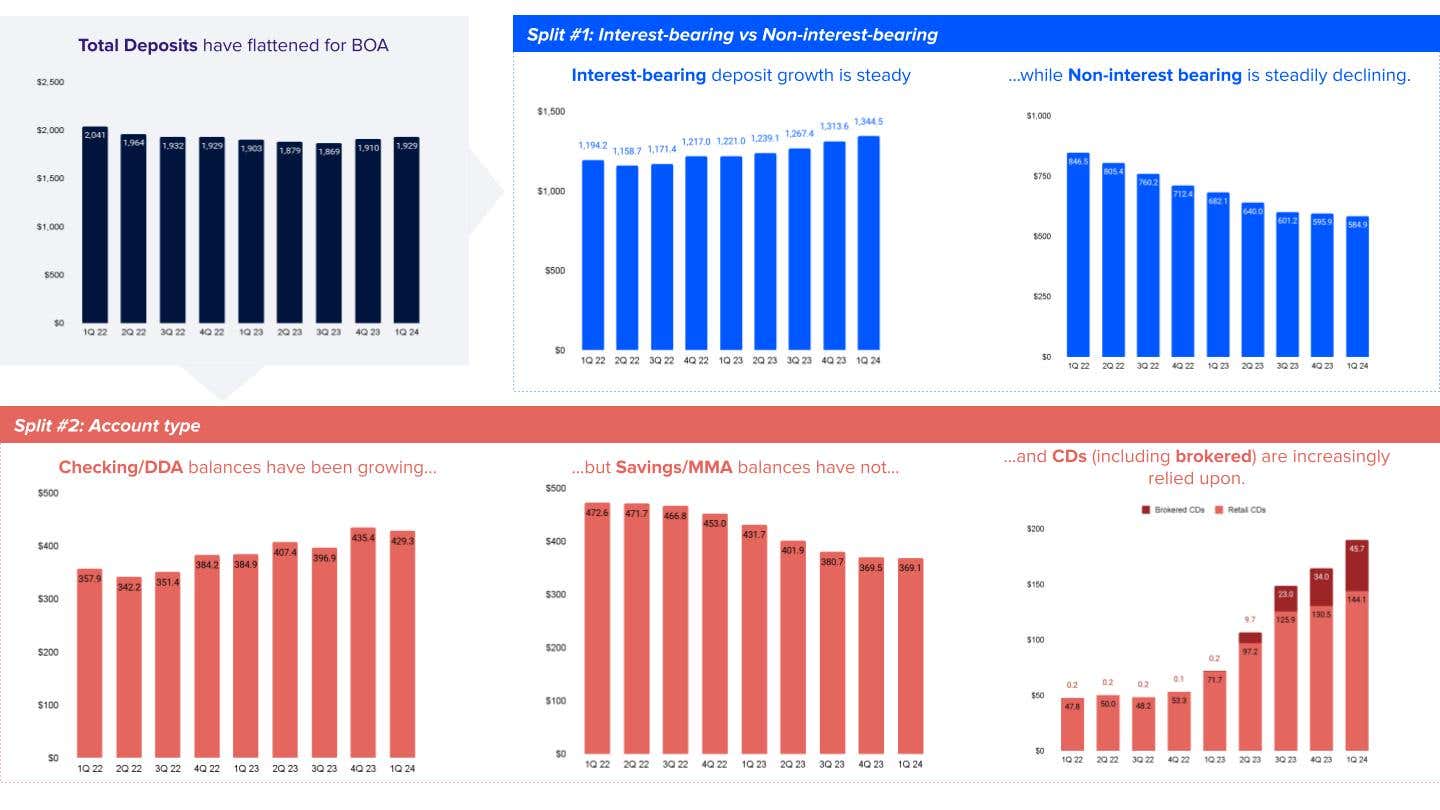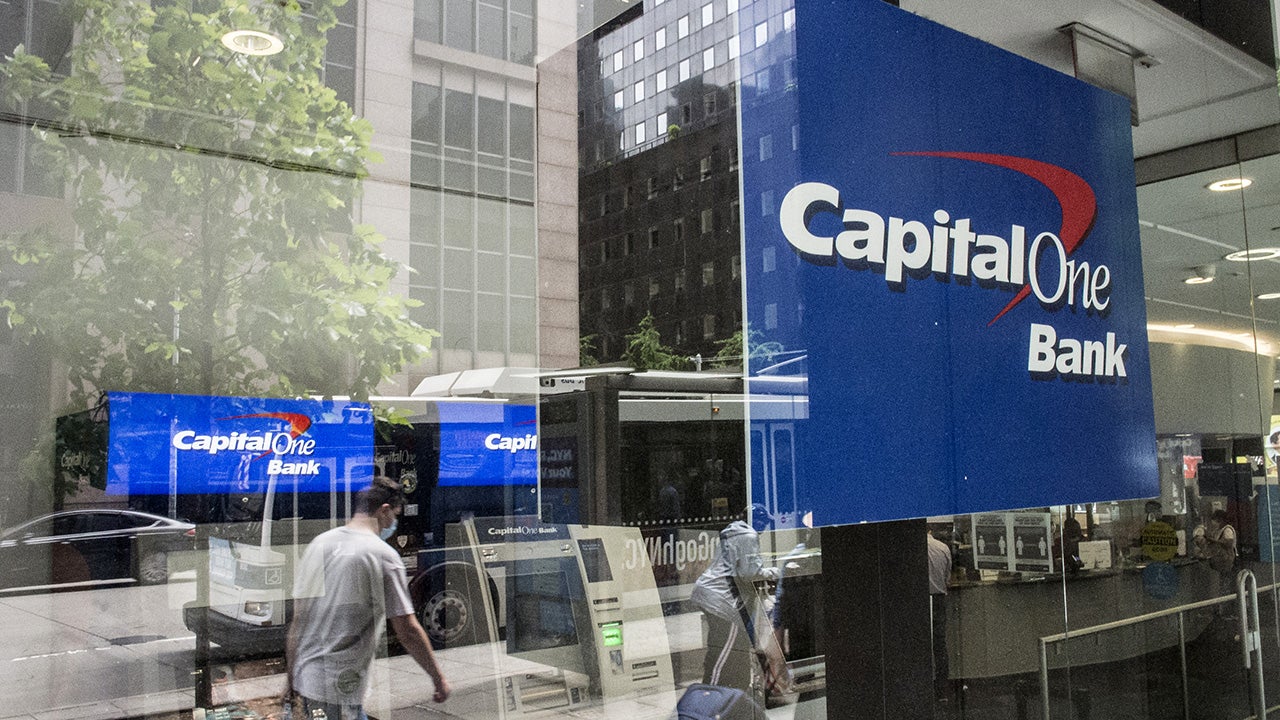Banks are relying more on brokered CDs as consumers shifted money out of low-interest accounts, FDIC data indicates

On any given day, our writers and editors are poring through data — be it from reputable and reliable sources such as government agencies, financial watchdogs and industry groups — to help our readers get a solid understanding of what’s shaping the economy and how it’s affecting our pocketbooks. Interpreting raw numbers can result in a compelling story, but the big challenge for us is that the story be told accurately and that it’s relevant to our readers.
Recently, our content operations team tipped me off to data they downloaded directly from the Federal Deposit Insurance Corp. (FDIC), that venerable government insurance organization created to protect consumers during bank failures. The data, released quarterly, takes inputs from call reports, earnings and other performance data from member banks and consolidates them into thick, lengthy tabular data. From that data download, we focused on 38 banks, ranging from big and regional banks to fintechs and online banks, that we feel provide a comprehensive view of the banking industry. Many stories can be gleaned from the FDIC’s most recent data set. Here’s one.
What the FDIC data tells us
At a time when online-only banks are primarily offering higher yields to draw customers away from big banks, or money centers, that often pay miniscule annual percentage yields (APYs) of 0.01 percent to 0.1 percent, many financial institutions – big and small – are, for the most part, increasing their assets in certificates of deposit (CDs), mainly brokered CDs. Increasing their deposits may help banks stem the outflow of cash from low-yielding, non-interest-bearing accounts.
The FDIC’s data shows that while some customers at major banks have been moving their cash out of low-interest accounts, total deposits have remained steady. Many of these banks have, in turn, been offsetting this decrease in funds in their low-yielding accounts by increasing their funds allocated in CDs and brokered CDs.
What does this mean for our readers? Well, first, it shows that banks are taking note that CDs have become an increasingly popular deposit account among savers over the past few years (although brokered CDs typically come from private wealth and brokerage firms, not banks). And as the federal funds rate remains at the target range of 5.25 to 5.50 percent (at least until the next Federal Reserve meeting), CDs are becoming more of a safe and reliable option for savers who want to stash their cash in a federally insured bank while earning a competitive amount of interest.
Meanwhile, some businesses and consumers are taking their money out of no- and low-yielding accounts at big banks, while migrating to online banks and fintechs for more competitive yields. As a result, among the biggest national banks, balances in checking, savings, or sometimes both, have generally declined while CD balances have grown along with rising interest rates.
“This data is a sign of a healthy market,” says Sayee Srinivasan, chief economist and head of research at the American Bankers Association. In an exclusive interview with Bankrate, Srinivasan noted that during the COVID pandemic, more money was deposited into the banking system than had been seen over the previous decade, as consumers looked for a safe place to park their cash. So, the moment the Fed started raising rates, people began moving their money to higher-yield accounts.
“This is typical deposit flow behavior that we’d expect to see in any rising rate environment,” Srinivasan adds. “Banks publish rates for CDs of various lengths, which consumers can consider as they review the best ways to achieve their financial goals.”
An example of market sentiment: Bank of America
This trend can best be seen in Bank of America, the second largest bank in the country, based on total domestic deposits of $1.93 trillion for the quarter ended March 31, according to the FDIC data. During the past two years, total domestic deposits were hovering at a range of between $1.87 trillion and $2 trillion. Despite total deposits remaining flat over that period, interest-bearing deposits showed steady growth, from $1.19 trillion in the first quarter of 2022, to $1.34 trillion as of March 31, 2024. At the same time, non-interest-bearing deposits steadily declined from $847 billion to $585 billion during the same period, a sign that some consumers and businesses saw the value of putting their money in accounts that help them make money in interest.
Concurrently, for account types, FDIC data for Bank of America shows that during the same two-year period, checking balances had been growing from $358 billion to $429 billion, while savings and money market account balances dropped from $473 billion to $369 billion. However, the most notable gainer for Bank of America over the past two years has been in CDs. In 2022, CD deposits were middling between $48 billion and $53 billion. But as the Fed aggressively raised interest rates over that year to help tamp down inflation, Bank of America saw deposits in CDs, including brokered CDs, rise in turn, from $72 billion at the end of the first quarter of 2023 to $191 billion as of March 31, 2024. Similar patterns can be seen among the three other large banks we analyzed from the FDIC data: Citibank, JPMorgan Chase and Wells Fargo.
By the numbers: Bank of America
The graphic below shows how deposits at major money center Bank of America have moved across its various accounts over the past two years. Thanks, in part, to such factors as less spending during the COVID pandemic and more higher-yielding deposit accounts, more money was deposited over the past two years into the banking system than over the previous decade, as consumers looked for accounts to secure their cash, notably interest-bearing deposit accounts. Meanwhile, as the Fed aggressively raised interest rates to help cut inflation, Bank of America saw deposits in CDs, including brokered CDs, rise in turn. Similar results have been seen at other major money centers.

What the FDIC’s data means for consumers
Question: Would you rather put your stash of cash in a savings account earning 0.01 percent APY, or one earning 5.35 percent APY? Actually, let me pose that question in a more practical way: If you had $5,000 to save, would you put it in a deposit account that pays you 50 cents after one year, or $267 (and 50 cents)?
No, this isn’t a trick question, but if you answered yes to $267.50, then you’re in good company as a growing number of depositors continue to take advantage of the meteoric rise in interest rates post-COVID. Between 2022 and 2023, for example, the Federal Reserve raised interest rates 11 times, with rate hikes as high as 75 basis points (or 0.75 percent) per each period, bringing the federal funds rate target from a paltry range of 0.25 to 0.50 percent in March 2022, to the current targeted range of 5.25 to 5.50 percent set last summer. Today, nearly one year later, that rate holds steady.
Although it’s only one bank, Bank of America is one of many financial institutions that appear to raise their funds allocated in retail and brokered CDs in response to depositor sentiment.
“I’m glad that depositors are showing rate awareness by moving money out of non-interest bearing accounts,” says Sheila Bair, former chair of the FDIC and founding chair and senior advisor to the Systemic Risk Council.
For many consumers, the rise in rates was as welcome as a desert nomad discovering an oasis. “Everyone got so used to getting nothing on their deposits during 14 years of ZIRP [zero interest-rate policy]. Even the mega banks are having to pay up. It’s very competitive out there,” Bair told Bankrate in an exclusive interview.
Top four big banks ranked by total domestic deposits, as of March 31, 2024.
| Bank | Total domestic deposits ($B) | Non-interest-bearing deposits ($B) | Interest-bearing deposits ($B) | Checking and direct deposit accounts ($B) | Savings and money market accounts ($B) | CDs – retail ($B) | CDs -brokered ($B) |
|---|---|---|---|---|---|---|---|
| Chase | $2,061.1 | $659.7 | $1,401.4 | $413.0 | $909.7 | $264.5 | $91.8 |
| Bank of America | 1,929.4 | 584.9 | 1,344.5 | 429.3 | 369.1 | 144.1 | 45.7 |
| Wells Fargo Bank | 1,414.4 | 393.0 | 1,021.4 | 833.3 | 354.0 | 112.0 | 101.6 |
| Citibank | 764.7 | 113.3 | 651.4 | 464.2 | 153.1 | 98.9 | 47.1 |
SOURCE: FDIC
CDs, HYSAs and bonds, oh my!
Despite the FDIC’s data suggesting the popularity of CDs and other deposit accounts, Bankrate’s national survey data tells another story, namely that a wide population of bank consumers are still missing out on taking advantage of high-yielding savings accounts. Granted, it’s keeping us and our esteemed online competitors in business, but in reality, it’s no laughing matter.
Our latest Financial Success Survey, released last month, found 89 percent of Americans said they haven’t yet achieved their idea of financial success. Within that group, 49 percent said they need to grow their savings (and, in a heartbreaking response, 9 percent said it doesn’t matter what they do with their money because they don’t think they’ll ever be financially successful).
Such responses are irksome to my colleague Greg McBride, CFA, Bankrate Chief Financial Analyst, who notes another Bankrate’s High-Yield Savings Survey from March which states that less than a quarter (22 percent) of Americans with savings are earning an APY of 4 percent or higher. And that’s at a time when competitive rates well above 5 percent APY are offered at nationally available banks, with little or no minimum deposit and literally within reach of everyone. “Those numbers would be much more dramatic if more people had taken an active role in their savings,” says McBride.
Inertia, or savers not moving their money out of low-yielding savings accounts, is a powerful force at play, but breaking that inertia can provide a saver a very good return on investment. If you can go from earning an APY of half a percentage point to 5.50 percent, you’re earning at least 10 times what you were earning previously on interest. “For every extra dollar you pull in through interest is a dollar you don’t have to work for,” McBride adds with a laugh.
There’s still time to save with higher interest
Those yearning to save more, and reap the benefits of higher APYs, can take advantage of the following types of deposit accounts:
CDs: The top-yielding CD rate across terms today is yielding at 5.36 percent APY on a one-year term. Because CDs tend to move in lockstep with the Fed’s interest rate moves, many banks and credit unions have raised their yields when the Fed raises rates (and lower yields when the federal funds rate drops). The benefits of putting your savings in a CD from a federally insured bank are that it’s safe and offers a fixed rate of return. That means if you open a five-year term CD at 4.50 percent APY, you’re guaranteed that APY for the next five years, even if interest rates were to drop incrementally. To see what’s out there, our comprehensive list of top-yielding, competitive CD rates is a great place to start your research.
But beware of early withdrawal penalties, as you can lose a sizable amount of any interest you accrued, and possibly some of your principal, because you decided to cash in early. Fortunately, if you’re too impetuous to keep your cash locked away for years, but still want that fixed rate of return, consider the strategy of CD laddering, where you open several CDs with different maturity dates.
High-yield savings accounts (HYSAs): Sure, top-yielding regular savings accounts are offering competitive APYs in the 5 percent range, but HYSAs provide an edge, offering APYs as high as 5.30 percent, as of mid-June. A high-yield savings account enables you to withdraw your money more easily than you can in a CD, but rates for high-yield savings accounts are variable and could fall should interest rates retreat. Still, HYSAs are safe accounts at federally insured financial institutions. Many HYSAs are available at online-only banks, although these banks offer digital tools that enable you to manage your savings easily through your computer, smartphone or tablet.
Series I savings bonds: Although not as high-earning as top-yielding CDs or savings accounts, Series I savings bonds are still a safe and trusted way to save money. Issued by the U.S. Dept. of Treasury, and backed by the full faith and credit of the U.S. government, the interest rate of a savings bond is bifurcated between a fixed rate and an inflation rate. The current interest rate on a Series I bond is 4.28 percent, which includes a fixed interest rate of 1.30 percent. Because a savings bond is a zero-coupon bond, it pays interest only when redeemed by the owner, and it earns interest for as long as 30 years.
The sky isn’t falling
One parting thought: Just because there’s talk of the Fed lowering interest rates this year, doesn’t mean there will be a sudden drop in interest rates to the point where all interest accrued will disappear in a flash. In the coming months, and years, the Fed will cautiously determine how, and when, to incrementally lower interest rates should they have to. Part of that depends on the country’s ability to tamp down inflation to the target rate of 2 percent. That’s not an easy, or immediate, goal, but one that will be achieved in good time. Don’t get caught up in the frenzy of fear that interest rates will immediately disappear.
Still not convinced? Consider this apt analogy from Bankrate’s McBride, in which he compares the movement of interest rates to that of a high-speed elevator in a tall skyscraper. “Interest rates took the elevator going up, but they’re gonna take the stairs going down. We took the elevator from the ground floor to, say, the 53rd floor. If we take the stairs down, we may get off at the 43rd floor or, over the course of the next couple of years, down to the 33rd floor, but it’ll still be a pretty good view,” he adds.
Bottom line
Reliable financial and economic data is key here at Bankrate, and interpreting that data through careful, skeptical analysis is what our team of writers and editors do on a daily basis. The FDIC’s latest data shows how banks have reacted over the past two years to higher interest rates and, to some extent, amplified the call for Americans to save more strategically in such deposit accounts as high-yield savings, CDs and even money market accounts. Heck, even some checking accounts pay interest as high as 4.60 percent APY.
Ultimately, it comes down to the financial needs of the consumer to determine the best approach to keeping, and building, one’s wealth safely and securely. Fortunately, there are many options, and still plenty of time to take advantage of high interest rates. “The smart consumer should be looking to maximize yield, while staying below the FDIC limits, of course,” says former FDIC chair Bair.
— Bankrate senior writer Karen Bennett contributed to this article.






